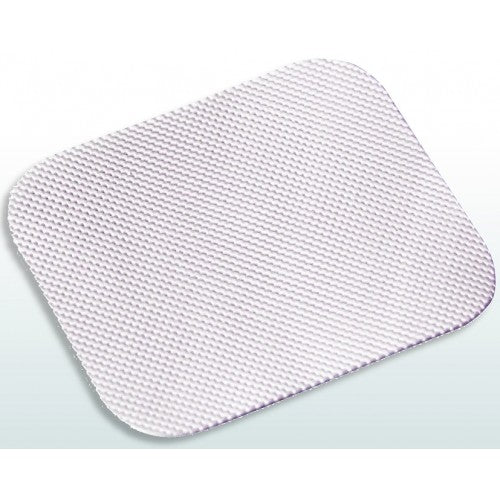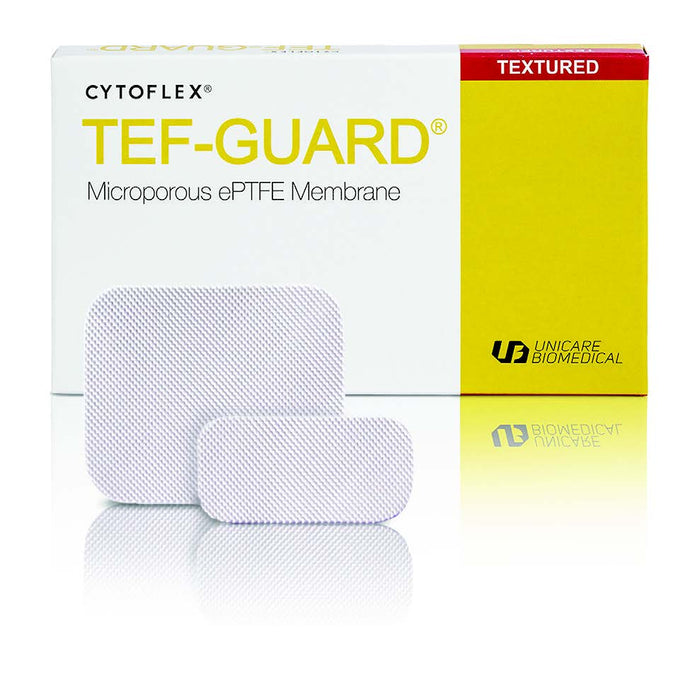
Cytoflex® Textured Tef-Guard® Membrane (12mm x 24mm) - 5/Box
For reconstruction of alveolar ridge and peridontal defects
- Easily adaptable
- Impenetrable by bacteria
- Easily retrievable as one piece
- Available as smooth or textured
Cytoflex Smooth Tefguard is a non-resorbable, space-making, barrier membrane intended for guided tissue regeneration procedures. Composed of proprietary micro-porous polytetrafluoethylene (ePTFE) thin film, Cytoflex smooth Tefguard has a surface texture and porosity suitable for host cells to attach upon. The micro porous surface is designed to prevent bacteria from penetrating through the membrane while promoting diffusion of interstitial fluid for optimal healing. It also allows for improved adhesion between gingiva tissue and the membrane, preventing passage and integration of bacteria within the interstices of the material.
The supple membrane conforms easily to tissue contours and offers sufficient rigidity to maintain space over the bony defect. The smooth version has micro pore texture on both surfaces. The cellular micro texture is invisible to the naked eye but can be seen at high magnifications.
Advantages of Micro-Pore Design
- Better host tissue attachment with fewer flap dehiscence
- Micro and optionally macro texture on both surfaces
- Easily tagged with bone screws or pins
- Excellent handling and ease of use
Cytoflex® Tefguard® Product Flyer (PDF File) and Case Review
Q&A with an experienced Tef-Guard® user
- Dr. David Kao, Periodontics and Dental Implants Fullerton, CA
1. How long have you used non-resorbable Cytoflex® Tef-Guard® products? What do you use the products mostly for?
I have used the products since 2011. Mostly I used them for socket grafting with the non-primary closure technique.
2. Do you notice any differences between smooth versus textured Cytoflex® Tef-Guard® products?
For the way I use Tef-Guard® in my office, I have not noticed little clinical differences in the smooth and textured. The handling property of the textured membrane is a bit improved over the smooth version. I find that the textured membrane is more durable. This does allow it to withstand the pressures tucking the membrane in below the gingiva. I also find that I can trim it better, but only marginally better. I will continue to use smooth only for its cost savings.
3. In your experience, what is the best way to use the product? Do you under-fill the bone graft or fill to the crest level of the bone before applying the membrane? What suturing technique do you use over the membrane? What kind of sutures do you use to close the wound?
In my experience, the best way to use the product is to stabilize the membrane by extending about 3 mm between the bone and the labial and lingual flaps. If the interdental papillae were not elevated, then a suture would not be necessary. If a suture were necessary, I would utilize a mattress suture over the membrane (either cris-cross or parallel). I commonly use a resorbable suture, such as chromic gut. I have tried both under-filling and over-filling. With the over-fill technique, it is common to experience non-integrated bone graft at the crest. I am inclined to say that under-filling works well.
I generally achieve good bone regeneration after 4-5 months of healing with just an allogenic bone graft (FDBA), Tef-Guard® membrane without primary closure in an intact tooth socket or a socket with minimal bone loss.
4. How long do you leave the membrane in place?
I try to leave the membrane in place for 4 weeks. After four weeks, you would get a moderately mature connective tissue with a few spicules of bone graft integrated in it. However, all cases end up with fully mature gingiva. After the removal of the membrane, the patient is advised to resume normal activity. No painkiller or dressings are needed.
5. What is the best way to remove the membrane? What instruments do you use?
I remove it by first lifting the membrane with a periodontal probe and extract it with cotton forceps.
6. Have you experienced any wound dehiscence while using this membrane? If so, what do you think caused the dehiscence?
Any thoughts to prevent such complications?
I have not experienced wound dehiscence with the non-primary closure technique. In general, wound dehiscence is caused by injury (either during or after the procedure), poor blood supply, or thin tissue.
7. Do you find Cytoflex® Tef-Guard® easy to use?
I do like the ease of use and would recommend Tef-Guard® products for socket grafting without primary closure.
FAQ's
1. How is this membrane different from Gore-Tex® and Cytoplast® membranes?
Micro porous Cytoflex® Tefguard® was designed to improve upon experiences learned from Gore-Tex® and Cytoplast® membranes. Macro porous Gore-Tex® was the gold standard of barrier membranes for use under primary soft tissue coverage. The macro pores were designed for tissue ingrowths to stabilize tissue/barrier interface. However, membrane removal after bone regeneration is traumatic. The featureless Cytoplast® membrane was designed to block off soft tissue and bacteria ingrowths, allowing the barrier to be used in non-primary coverage conditions. The relatively non-porous nature of the barrier limits nutrient permeation across the membrane. Cytoflex® Tefguard's® proprietary micro pores were designed to allow nutrient permeation and at the same time prevent penetration of soft tissue and bacteria across the membrane. The combination of nutrient diffusion and micro porous texture enhances soft tissue attachment while preventing bacteria penetration across the membrane.
2. What about primary soft tissue coverage of the membrane?
Cytoflex® Tefguard® membranes were designed to serve as a barrier to contain the bone graft material and prevent soft tissue and bacteria in-growth. At the discretion of the practitioners, the barriers have been used in primary coverage and non-primary coverage situation when soft tissue coverage is lacking. The membrane was designed to block off bacteria and thus exposure of the membrane does not result in infection and case failure.
3. How long can the membrane stay in place?
In general within three to four weeks the membrane will need to be removed. This will allow enough time for the osseous tissue to begin forming and to be able to resist soft tissue from invading the graft site. However, at the discretion of the clinician, primary closure and longer healing times may be considered, if desirable.
4. How to remove the membranes?
Under primary coverage condition, Cytoflex® Tefguard® membrane may be easily removed by creating a small incision in its proximity. With forceps, firmly grasp a border of the material and remove it from the tissue. Local anesthesia is normally used for this procedure. In non-primary coverage situation, the membrane may be lifted with a periodontal probe and extracted with a forcep. After membrane removal, re-epithelialization will occur within two to three weeks to complete the healing process. Final bone maturation will take place for six to twelve months from the time of implantation. This time frame should be considered in treatment planning cases involving heavy prosthetic loading of regenerated bone.
5. What is the difference between the Smooth and Textured Cytoflex® Tefguard® barrier membranes? What are the benefits of each as opposed to the other?
Both Cytoflex® Tefguard® membranes have micro-texture. The micro texture allows for better soft tissue attachment over the membrane and a better seal around the bone graft area. The Textured Cytoflex membranes also provide a visible macro-texture similar to the configuration of strawberry fields as opposed to the conventional pot-hole design of other barrier products. This strawberry field texture was designed to further enhance soft tissue attachment and minimize dehiscence over the grafting site.
6. Can unused portions of the membrane be resterilized?
No, Cytoflex® Tefguard® membranes are designed for a single use only.
7. What is the shelf life the Cytoflex® Tefguard® membranes?
Each sterile Cytoflex® Tefguard® barrier is double packed and has 6-year of shelf life from the date of manufacture.
8. Have you ever had a confirmed allergic reaction to micro porous Cytoflex® Tefguard® membranes?
Cytoflex® Tefguard® membranes are made of inert and biocompatible PTFE materials. Since it was cleared in 2002, there have not been any reported allergic reactions caused by Cytoflex® Tefguard® PTFE barrier.
9. Are there any contraindications?
Cytoflex® Tefguard® membrane is a passive, non-load bearing material and should not be used for load bearing applications. Cytoflex® Tefguard® should not be considered for patients where general oral surgery is not advisable.
10. What are the potential complications?
Possible complications associated with any oral surgery include infection, flap slough, perforation, abscess formation, bone loss, pain and complications associated with the use of anesthesia. Depending upon the type and severity of the complication, as judged by the clinician, early material removal may be required.
Specifications
| Size: | 12mm x 24mm |
| Qty Per Box: | 5/Box |
| Product Code: | C04-0105 |



